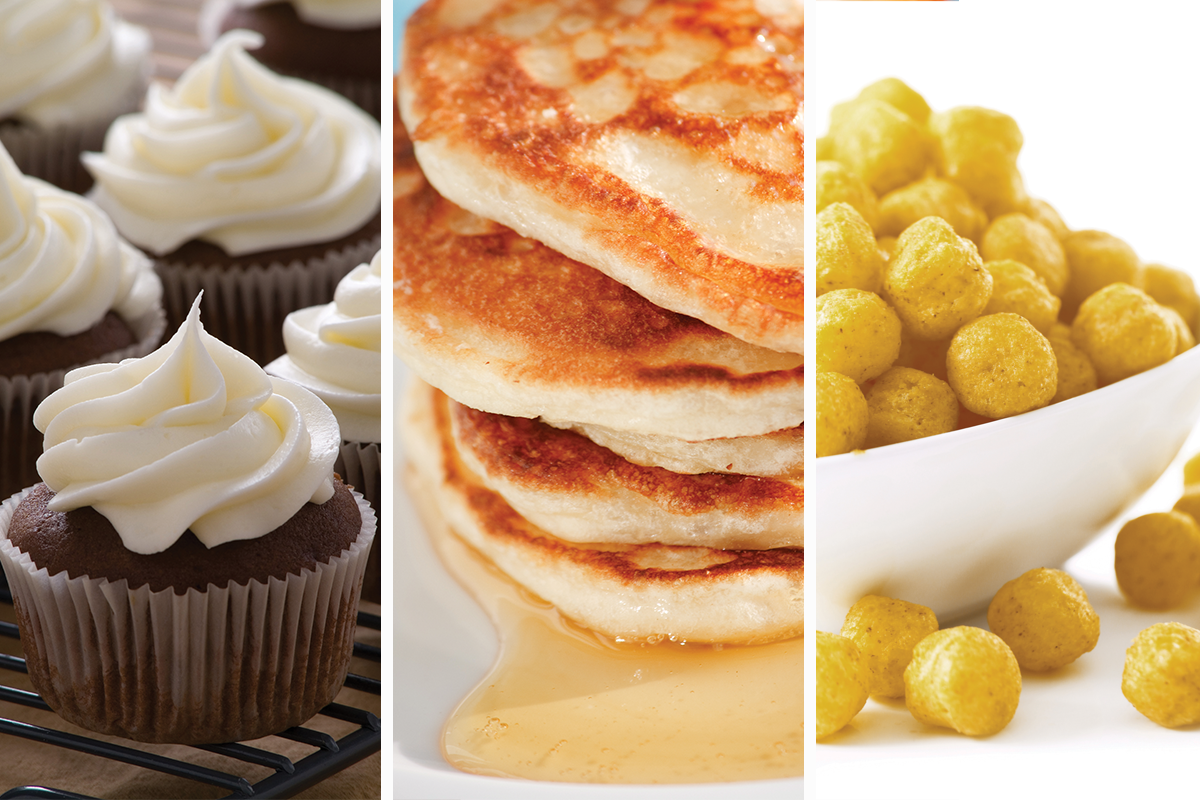KANSAS CITY — Plant-based is a descriptor being used across the supermarket without any regulation. Some may think it’s suggestive of vegetarian or vegan, but that’s all it is: a suggestion. Grain-based baked goods have always been plant-based. It’s the concept of plant-based protein that has sparked the curiosity of bakers, as these ingredients are often designed to replace traditional animal-based proteins, namely eggs, as well as whey and casein from milk, for various reasons, including achieving a vegan claim, lowering cost and better managing unpredictable markets.
Sometimes protein is added to enhance the quality of flour, while other times it’s to improve processing. Bakers may simply want to boost total protein content for consumer appeal. These are just some of the reasons why a baker may add plant protein to a formulation, and there are a growing number of options in the marketplace.
“When evaluating plant proteins, it is important to consider the protein concentration,” said Jim Mitchell, director of product engineering, Ciranda. “In most bakery applications, an isolated or highly concentrated protein source with 80% to 90% protein is not needed.”
Lower concentrated proteins and protein flours may deliver enough functionality. They will also increase protein content when compared to traditional baking flours.
“Finding the best plant protein for baked goods relies on choosing the right protein for the application versus choosing the right baked good for the protein,” said Erin Nese, technologist, commercial innovation acceleration, Ingredion.
Back to the grain
Sometimes plant proteins can assist in managing the inconsistency that can come with flour quality.
“Occasionally bakeries have to contend with variabilities in the quality of raw material flour,” said
Tanya Jeradechachai, vice president of ingredient solutions research and development, MGP Ingredients.
“In cases where the flour is of marginal quality, anelastic wheat protein isolate can remedy the problem.”
It makes sense to put wheat proteins back into wheat. Wheat proteins can be used to overcome other quality issues, too.
“In yeast-leavened bread, for example, these unique functional properties allow wheat protein isolate to reduce dough mixing time, support gas cells in dough, yield a satisfactory loaf volume and provide a soft spongy crumb texture with excellent mouthfeel,” Ms. Jeradechachai said. “High-protein breads with high levels of added vital wheat gluten produce very strong doughs that require the addition of wheat protein isolate to increase extensibility.”
There are high-protein baked goods, and then there are keto-friendly high-protein products. The keto diet is about 70% fat, 20% protein, and 5% each simple carbohydrates and non-starchy vegetables, which means keto-friendly baked goods are also low in carbohydrates.
“Wheat-based keto bakery applications require a large amount of wheat proteins,” Ms. Jeradechachai said. “Wheat protein isolate is often used in combination with vital wheat gluten to provide extensibility properties and help with dough handling.”

Leaning on legumes and peas
Soy protein and pea protein both are used extensively in baked goods. A benefit of using pea protein is that it’s not an allergen. There are varied formats designed for specific applications.
“Some pea proteins are better suited to crackers, where it’s important to prevent staling and moisture migration,” said McKenna Mills, senior technical services specialist for bakery, Cargill. “Others work better in breads, where controlling dough viscosity is a bigger priority. We even offer pea protein crisps, a great way to introduce a unique texture experience into a bar or snacking application.
“Soy flour, a source of soy protein, has good supply chain availability, and it’s very economical,” she continued. “It is used in baked goods, especially sweet baked goods like snack cakes, for partial replacement of eggs as a cost-saving measure. It can also improve the elasticity of doughs, help control the viscosity of batters and enhance the crumb structure of breads. In donuts and other fried products, soy protein can help reduce fat absorption. It’s also used in some gluten-free bakery applications, where it adds body and viscosity to batters.”
Soy flour can replace 25% of liquid whole eggs in muffins and up to 50% in cookies and pancakes. In these applications, soy flour helps maintain moisture and acts as a fat mimetic.
Ciranda’s plant protein solutions are produced from organic fava beans and organic brown peas, which are grown in Europe as part of a sustainable organic farming system. Each are available at two different protein levels.
“We’ve successfully baked gluten-free bagels and focaccia, which closely mimic the texture and flavor ofthe traditional grain-based goods,” Mr. Mitchell said. “The formulas include various native and pre-gelatinized starches, cassava, or tapioca, flour and fava bean flour with 25% protein. The fava bean protein contributes texture and is essential for producing the typical ‘baked bread’ aroma that is often absent in gluten-free due to the removal of wheat proteins.”
The company also developed a vegan Brazilian cheese bread, which traditionally includes cheese and egg. Using the pea protein flour with 50% protein to replace the egg, and the fava bean flour with 25% protein to produce a vegan cheese, the cassava-based gluten-free bread is now vegan, too.
Ingredion offers plant protein solutions, including flours, concentrates and isolates. The flours range from 10% to 30% protein on a dry basis, depending on their base and processing parameters. Bases include quinoa and pulses, such as yellow pea, yellow lentil, fava bean, red lentil, green pea and chickpea.
“The concentrates are available in yellow pea, yellow lentil and fava bean,” Ms. Nese said. “They are 55% to 60% protein on a dry basis. Pulse concentrates can improve nutritional profiles in baked goods with their balance of protein, fiber and micronutrients.”
Isolates are sourced from yellow peas and label as pea protein. They are 80% to 85% protein on a dry basis and can boost protein content in applications with other added benefits specific to applications.
“For example, pea protein isolates have a high water-holding capacity,” Ms. Nese said. “This can help relieve dough stickiness or improve dough handling.”
Merit’s line of canola ingredients is labeled as “canola protein.” Bakers find it to be useful for total egg replacement.
“Napin, the albumin fraction found in canola protein, shares egg albumen’s unique ability to whip in air and create nucleation sites in batter formulations,” said Jeff Casper, director of research and applications at Merit. “And when combined with the gelation functionality ofcruciferin, the globulin fraction in canola protein, it can set into a stable crumb. Canola proteins can be used to replace whole fresh or dried egg whites in batter mixes to achieve a truly plant-based product, without sacrificing taste and texture.”
It also makes vegan marshmallows and meringues possible. Canola protein whips into a foam that supports the creation of stable, aerated confections, even puffy, vegan, soy-free marshmallows that toast and taste just like traditional applications, Mr. Casper said.

Power in nuts
Nuts in their various powder and flour formats can provide plenty of functionality to baked goods. Olam Food Ingredients now offers nut protein powders, which are manufactured by mechanical pressing of sustainably grown almonds and cashews. The almond protein powder is also a good source of essential micronutrients, including potassium and magnesium. The cashew protein powder is low in carbohydrates and allows for a 50% reduction in added fat in some baked goods.
“Raw or blanched almond protein powder can be used to create moist vegan and gluten-free muffins, with added nutritional credentials,” said J.I.X Antony, vice president of ingredient excellence at Olam. “In combination with wheat flour, almond protein powder can support moisture retention thanks to its fiber content, helping producers avoid the dry, even chalky texture that wheat-free baked goods can often develop. “Consumers have little tolerance for these flavor hiccups,”
Ms. Mills said. “Some options, like our pea protein, have a more neutral flavor profile. The yellow pea seed varieties are specially selected to minimize off-notes and processed without the use of hexanes to bring out the best flavor possible. To further minimize flavor nuances, we may advise bakers to use blends of four or more different proteins so none of them imparts an off flavor.”
ADM focuses on creating customized plant protein systems to assist formulators with achieving their end product goals. The company’s portfolio includes proteins isolated from varied beans, grains, nuts, pulses and seeds.
“We’re able to bring all of these pieces together in proprietary systems designed to maximize functionality, nutrition, sensory appeal and speed to market,” said Jacquelyn Schuh, global marketing director, protein nutrition solutions at ADM. “Combining different plant proteins helps product developers address consumer interest in better-for-you bakery and snacks with ingredient diversity, great flavor and enhanced nutrition.”
Plant-based proteins pair well with certain flavors in baked goods. Ms. Nese said that chocolate, cinnamon and peanut butter are some of the best suited profiles. More recent additions to ADM’s plant protein portfolio are hemp powder and hemp hearts, which are dehulled hemp seeds. Both may enhance protein levels in baked goods.
“Not only are hemp hearts and hemp powder appealing to health-conscious consumers, but they are also incredibly versatile ingredients. Both achieve great taste and texture in loaves, cereals and snack bars,” Ms. Schuh said. “They also are an ingredient that can deliver fiber, omega-3 and omega-6 fatty acids.”
Moisture management is paramount when adding proteins to a bakery formulation.
“Over or under absorption of water can impact texture, volume, shelf life and more,” Ms. Mills said. “However, with careful protein selection, it is possible to manage water absorption issues and create high-protein baked products that are nearly indistinguishable from their ‘normal’ counterparts. Using protein blends is often the key, countering high-absorbing (binding) proteins with low-absorption (plasticizing) proteins.”
While conventional baked goods stale due to starch retrogradations, Mike Merkley, senior scientist, bakery applications, Tate & Lyle, pointed out that high protein baked goods can also become firm over time but for different reasons.
“Hardening associated with protein matrices is complex and can include protein self-aggregation, sugar crystallization and water migration,” he explained. “An understanding of these hardening mechanisms and ingredient solutions that can disrupt these pathways have potential to extend shelf life and maintain texture.”
Texturants and bulk sweeteners may assist. With a growing trend toward high protein also being reduced sugar and lower carbohydrate, that toolbox of ingredients gets smaller.
“Allulose and fructose provide bulk and help maintain texture in high-protein systems through their tendency to resist crystallization and add humectancy,” Mr. Merkley said. “Soluble corn fiber is another effective solution for added moisture retention. Soluble corn fibers impart little to no color or flavor and reduce mobility of water.”
Phosphates may also assist with improving volume, texture and hardness. They do this by helping release carbon dioxide, thereby creating airiness in the baked good. These leavening technologies may also help bakers with sodium reduction, adding calcium and achieving a gluten-free label.
“When using plant proteins in formulations, the baked product loses carbon dioxide during the process, which results in a baked product having less volume,” said Amr Shaheed, technical services and application development manager, Innophos. “The product becomes more dense due to the heaviness of the protein. Phosphates provide aeration, leavening and increase the softness of a product.”
Certain flavor profiles like maple bacon, chocolate, cinnamon and peanut butter can pair well with protein ingredients and offset their taste profile.





